Recipes & Culinary Uses
Make Your Own Cocoa Butter: 3 Easy Steps

I am here to assist you in creating your own cocoa butter. Prepare yourself for a cocoa-filled journey as we explore the captivating realm of cocoa beans.
In this article, I’ll be sharing with you the step-by-step process of selecting the perfect beans, sorting and cleaning them, and extracting the rich cocoa liquor.
We’ll also explore how to cool and solidify the butter, store it, and even use it in homemade skincare products.
So, grab your apron and let’s dive into the wonders of cocoa butter making!
Key Takeaways
- Cocoa beans must be properly sorted, cleaned, roasted, and ground to make high-quality cocoa butter.
- Experimenting with spices, flavorings, nuts, and fruits can enhance the flavors of cocoa.
- There are traditional and solvent extraction methods to extract cocoa liquor from ground beans.
- Cocoa butter can be separated from cocoa liquor using a hydraulic press, and further processing can extract any remaining cocoa butter from cocoa solids.
Understanding the Basics of Cocoa Beans
To understand the basics of cocoa beans, you’ll need to know where they come from and how they are processed.
Cocoa beans are the seeds of the cacao tree, which is native to tropical regions. After harvesting, the beans are removed from their pods and left to ferment for several days. This fermentation process is crucial as it develops the characteristic flavors and aromas of cocoa.
The fermented beans are then spread out to dry under the sun. Drying is essential to reduce moisture content and prevent the growth of mold or bacteria. Once dried, the cocoa beans are ready for further processing. This involves roasting, grinding, and pressing to separate the cocoa solids from the cocoa butter.
Transitioning into the next section, selecting the right cocoa beans is vital to ensure high-quality cocoa butter production.
Selecting the Right Cocoa Beans for Cocoa Butter Making
When selecting the right cocoa beans for making cocoa butter, it’s important to consider their quality and origin. The quality of the beans greatly impacts the final product, so choosing beans that are fresh and free from defects is crucial. Look for beans that have a rich, chocolatey aroma and a glossy appearance.
Additionally, the origin of the beans can affect the flavor profile of the cocoa butter. Beans from different regions have distinct flavor characteristics, so it’s worth exploring different origins to find the taste that suits your cocoa butter recipes.
By carefully selecting high-quality beans and experimenting with different origins, you can unlock the full potential of cocoa butter and enjoy its numerous benefits.
Now, let’s delve into the next step of the cocoa butter making process – sorting and cleaning the cocoa beans.
Sorting and Cleaning the Cocoa Beans
When it comes to cocoa butter making, the quality of the beans used can greatly impact the final outcome. The flavor, texture, and aroma of the cocoa butter are all heavily influenced by the quality of the beans.
Additionally, proper cleaning of the beans is crucial in ensuring that only the highest quality beans are used, as any contaminants or impurities can negatively affect the final product.
Bean Quality Affects Outcome
Choosing high-quality beans ensures a better outcome for your cocoa butter. The quality of the beans used in the production of cocoa butter greatly affects its final properties and benefits. Here are three key factors to consider when sourcing your beans:
-
Origin: The geographical location where the beans are grown plays a crucial role in their flavor and quality. Different regions produce beans with distinct characteristics, so it’s important to choose beans from reputable sources.
-
Variety: There are various cocoa bean varieties, each with its unique flavor profile. Selecting beans from well-known varieties, such as Criollo or Trinitario, can enhance the taste and aroma of your cocoa butter.
-
Processing: The way the beans are processed after harvesting also impacts the quality of the cocoa butter. Look for beans that have been properly fermented and dried to ensure optimal flavor and texture.
Proper Cleaning Ensures Quality
Properly cleaning the beans is essential to ensure the quality of your cocoa butter. Cleaning techniques and maintaining equipment play a crucial role in achieving the desired outcome. When it comes to cleaning cocoa beans, there are several effective methods to consider. One popular technique is the wet method, where the beans are soaked in water to remove impurities. Another method involves using a winnowing machine to separate the husks from the nibs. It is important to regularly clean and maintain your equipment to prevent cross-contamination and ensure optimal performance. Regularly inspecting and servicing your machines will help extend their lifespan and ensure consistent results. By implementing proper cleaning techniques and maintaining your equipment, you can produce high-quality cocoa butter that is free from contaminants and impurities.
| Cleaning Techniques | Maintaining Equipment |
|---|---|
| Wet Method | Regular Inspection |
| Winnowing Machine | Servicing |
| Preventive Maintenance |
Roasting and Grinding the Cocoa Beans
When it comes to roasting cocoa beans, there are several techniques that can be employed. The roasting process is crucial as it helps develop the flavors and aromas in the cocoa beans. Different roasting temperatures and times can result in varying flavor profiles, from fruity and acidic to deep and rich.
Once the beans have been roasted, they can be ground to produce cocoa butter, a key ingredient in chocolate making. Grinding the roasted cocoa beans releases the fat content, which solidifies into cocoa butter.
Roasting Techniques for Cocoa
To enhance the flavor of your cocoa beans, try roasting them at different temperatures and durations. Roasting is a crucial step in the cocoa bean processing that plays a significant role in flavor development.
Here are three roasting techniques that can help you achieve the desired flavor profile:
-
Low-temperature roasting (120-140°C): This technique preserves the delicate flavors of the cocoa beans and is ideal for producing mild and fruity profiles.
-
Medium-temperature roasting (140-160°C): This technique brings out a balanced flavor profile, combining fruity and nutty notes.
-
High-temperature roasting (160-180°C): This technique creates a robust and intense flavor profile with deep cocoa and roasted notes.
Grinding Cocoa for Butter
Grinding cocoa beans for butter can be achieved by using a grinder or a food processor. Both methods have their advantages and can produce smooth and creamy cocoa butter. When using a grinder, it is important to ensure that the beans are dry and free from any moisture. The grinder should be set to a medium setting for optimal results. On the other hand, a food processor can also be used to grind cocoa beans into butter. It is recommended to use the pulse function to prevent overheating the beans and to achieve a fine consistency. Additionally, grinding cocoa beans can have alternative uses, such as making homemade chocolate or incorporating it into various recipes like desserts or skincare products.
| Advantages of Grinder | Advantages of Food Processor |
|---|---|
| Produces fine and smooth texture | Pulse function prevents overheating |
| Easy to use and clean | Versatile for other recipes |
| Allows for control over grinding consistency | Efficient and quick process |
Enhancing Flavors in Cocoa
If you want to enhance the flavors in your cocoa, try experimenting with different spices and flavorings. Adding these ingredients can create a delightful and unique taste experience. Here are three flavor pairings to consider:
-
Cinnamon: This warm and aromatic spice pairs beautifully with cocoa. It adds a subtle sweetness and depth to the flavor profile.
-
Vanilla: The smooth and creamy notes of vanilla complement the rich taste of cocoa. It adds a touch of sweetness and enhances the overall flavor.
-
Peppermint: The cool and refreshing taste of peppermint can provide a delightful contrast to the richness of cocoa. It adds a refreshing twist to your hot cocoa.
In addition to enhancing the flavors, cocoa butter also offers numerous benefits. It is rich in antioxidants and helps moisturize the skin. Cocoa butter can also improve blood flow and reduce inflammation. So not only will your cocoa taste amazing, but it will also provide some added health benefits.
Extracting Cocoa Liquor From the Ground Beans
Once you’ve roasted the cocoa beans, you can start grinding them into a fine powder. The next step is to extract cocoa liquor from this ground powder. Cocoa liquor is the liquid form of chocolate obtained by separating cocoa solids from cocoa butter. There are various methods for extracting cocoa liquor, including the traditional method and the modern solvent extraction method.
| Method | Description | Advantages | Disadvantages |
|---|---|---|---|
| Traditional Method | Involves grinding the cocoa nibs into a paste and then applying pressure to extract the cocoa liquor. | – Retains the natural flavors and aromas of cocoa. – No chemicals used. | – Time-consuming process. – Requires specialized equipment. |
| Solvent Extraction Method | Uses solvents like hexane to separate cocoa butter from the cocoa solids. | – Faster process. – Higher extraction yield. | – May alter the natural flavors and aromas of cocoa. – Requires careful removal of residual solvents. |
Both methods have their pros and cons, and the choice depends on factors like time, resources, and desired outcome.
Separating Cocoa Butter From Cocoa Liquor
To extract cocoa butter from cocoa liquor, the process of cocoa liquor separation is employed. This involves subjecting the cocoa liquor to a series of mechanical and thermal treatments.
First, the cocoa liquor is passed through a hydraulic press to separate the cocoa solids from the cocoa butter.
Then, the remaining cocoa solids are further processed to extract any remaining cocoa butter through a combination of heat and pressure.
Extracting Cocoa Butter
You can start extracting cocoa butter by grinding the cocoa nibs into a fine powder. This process helps to release the fat content in the nibs, which is the cocoa butter. Once you have the cocoa powder, you can proceed with the extraction process.
Here are three steps to follow:
-
Heat and melt the cocoa powder: Place the cocoa powder in a double boiler and heat it gently until it melts. This will separate the cocoa butter from the remaining solids.
-
Strain the mixture: Pour the melted cocoa powder through a fine mesh strainer or cheesecloth to remove any remaining solids. This will ensure a smooth and pure cocoa butter.
-
Cool and solidify: Allow the strained cocoa butter to cool and solidify. Once it has hardened, you can use it for various purposes, such as making homemade chocolate recipes or using it as a moisturizer due to its numerous cocoa butter benefits.
Making your own cocoa butter at home opens up a world of possibilities for homemade cocoa butter recipes and allows you to enjoy the many benefits it offers.
Cocoa Liquor Separation
When separating cocoa liquor, it’s important to strain the mixture to remove any remaining solids. Cocoa liquor separation is a crucial step in the process of cocoa butter extraction.
After the cocoa beans are roasted and ground, they are processed to form a thick paste known as cocoa liquor. This paste contains both cocoa solids and cocoa butter.
To separate the cocoa butter from the solids, the cocoa liquor is passed through a series of filters and strainers. These filters remove any remaining solid particles, leaving behind the liquid cocoa butter.
The filtered cocoa butter is then further processed to remove any impurities and refine its texture. This process ensures that the resulting cocoa butter is pure and of high quality, ready to be used in various applications such as chocolate making or skincare products.
Moving on to the next step, let’s discuss the process of filtering and straining cocoa butter.
Filtering and Straining Cocoa Butter
Using a fine mesh strainer, strain the melted cocoa butter to remove any impurities. This step is crucial in the process of making cocoa butter as it helps ensure the final product is of high quality. There are various filtering techniques and straining methods that can be employed to achieve the desired result. Here are three effective methods:
-
Gravity filtration: This method involves pouring the melted cocoa butter through a strainer or filter paper, allowing gravity to pull the liquid through while leaving behind any solid particles or impurities.
-
Centrifugal filtration: In this method, the melted cocoa butter is passed through a centrifuge, which uses centrifugal force to separate the impurities from the butter. This method is particularly effective in removing fine particles.
-
Charcoal filtration: Activated charcoal is often used as a filtering agent to absorb any remaining impurities in the cocoa butter. The melted butter is passed through a bed of activated charcoal, which traps the impurities and leaves behind a clean and pure cocoa butter.
Cooling and Solidifying Cocoa Butter
To cool and solidify the cocoa butter, simply place it in the refrigerator until it hardens.
Cooling is a crucial step in the process of making cocoa butter, as it helps to achieve the desired consistency and texture.
There are different methods to cool cocoa butter, depending on the consistency you want to achieve.
For a softer consistency, you can cool the cocoa butter at room temperature for a longer period of time. This will result in a more spreadable and creamy texture.
On the other hand, if you prefer a firmer consistency, you can cool the cocoa butter in the refrigerator for a shorter period of time. This will yield a harder and more solid texture, ideal for making chocolate bars or other confections.
Once the cocoa butter has hardened, it is ready for the next step of storing and preserving.
Storing and Preserving Cocoa Butter
Storing and preserving cocoa butter is important to maintain its freshness and quality. As a chocolate enthusiast, I have done extensive research on cocoa butter storage tips to ensure that my supply remains in optimal condition. Here are three key tips to help you preserve your cocoa butter:
-
Keep it in a cool and dark place: Cocoa butter is sensitive to light and heat, which can cause it to deteriorate and lose its quality. Therefore, storing it in a cool, dark pantry or cupboard is crucial.
-
Seal it tightly: Cocoa butter has a tendency to absorb odors from its surroundings. To prevent this, make sure to store it in an airtight container or wrap it tightly with plastic wrap to maintain its original aroma and flavor.
-
Avoid moisture exposure: Moisture can cause cocoa butter to become rancid. It is essential to keep it away from any sources of moisture, such as water or condensation, to ensure its longevity.
Using Cocoa Butter in Homemade Skincare Products
One of the benefits of incorporating cocoa butter into homemade skincare products is that it helps to deeply moisturize and nourish the skin. Cocoa butter is rich in fatty acids, which provide essential hydration and create a protective barrier on the skin’s surface. It also contains antioxidants that can help to combat free radicals and promote a more youthful appearance. When used for hair care, cocoa butter can help to improve the overall health and condition of the hair, making it softer and more manageable. Additionally, cocoa butter has been found to have anti-inflammatory properties, which can help to soothe irritated skin and reduce redness.
| Benefit of Cocoa Butter for the Skin | Benefit of Cocoa Butter for Hair Care |
|---|---|
| Deeply moisturizes and nourishes | Improves overall hair health |
| Provides essential hydration | Makes hair softer and more manageable |
| Creates a protective barrier | |
| Contains antioxidants | |
| Has anti-inflammatory properties |
Incorporating cocoa butter into homemade skincare products can be a game-changer for achieving healthy, radiant skin. Now, let’s move on to the next section and explore some troubleshooting tips for making cocoa butter at home.
Troubleshooting Tips for Making Cocoa Butter at Home
When making cocoa butter at home, it is important to be aware of common mistakes that can occur during the process. Troubleshooting these issues can help ensure that you end up with a high-quality cocoa butter product.
Here are some troubleshooting techniques to keep in mind:
-
Insufficient roasting: One common mistake is not roasting the cocoa beans enough. This can result in a weak cocoa flavor and a lack of aroma in the final product. Make sure to roast the beans for the recommended time and temperature to achieve the desired flavor profile.
-
Overheating: Another mistake is overheating the cocoa butter during the extraction process. This can cause the cocoa butter to lose its natural properties and become rancid. Maintain a moderate heat level and monitor the temperature closely to prevent overheating.
-
Improper storage: Improperly storing cocoa butter can lead to degradation and spoilage. It is essential to keep it in an airtight container, away from moisture, heat, and direct sunlight, to maintain its quality and extend its shelf life.
Frequently Asked Questions
How Long Does It Take to Make Cocoa Butter From Start to Finish?
I can’t answer your question without the context of how to make cocoa butter. However, factors affecting the quality of homemade cocoa butter include temperature, bean quality, and processing time. Tips for speeding up the process may include using higher temperatures and grinding the beans finely.
Can I Use Any Type of Cocoa Beans to Make Cocoa Butter?
Yes, you can use different types of cocoa beans to make cocoa butter. Homemade cocoa butter has benefits over store bought options, such as freshness and control over the quality of ingredients used.
Do I Need Any Special Equipment to Roast and Grind the Cocoa Beans?
I don’t need any special equipment to roast and grind cocoa beans. Roasting techniques can vary, but using an oven or stovetop works well. For grinding, a food processor or grinder is suitable.
Can I Use Cocoa Powder Instead of Cocoa Liquor to Make Cocoa Butter?
No, using cocoa powder instead of cocoa liquor to make cocoa butter is not recommended. Cocoa powder lacks the necessary fat content, resulting in a different texture and flavor. Cocoa liquor is the preferred ingredient for making cocoa butter.
How Long Can I Store Homemade Cocoa Butter Before It Goes Bad?
The shelf life of homemade cocoa butter depends on proper storage. It can last up to a year if stored in an airtight container in a cool, dark place. Regularly check for signs of spoilage like rancidity or mold.
Conclusion
In conclusion, making cocoa butter at home requires a thorough understanding of the cocoa bean and a careful process of sorting, roasting, grinding, and extracting.
By following the steps outlined in this article, you can create your own high-quality cocoa butter for use in homemade skincare products.
With proper storage and preservation techniques, you can enjoy the benefits of cocoa butter for a long time.
So why not embark on this exciting journey of creating your own cocoa butter and enhance your skincare routine?
From sneaky childhood butter licks to penning some of our most popular articles, Jamie’s journey with butter has been lifelong. His culinary background gives him a unique perspective, allowing him to craft mouthwatering articles that educate and tantalize equally. Jamie’s travel adventures revolve around finding the world’s best buttery treats when he isn’t writing.
Recipes & Culinary Uses
Gourmet Lobster: Best Butter Poached Lobster Recipe!
Celebrate culinary excellence with our luxurious butter-poached lobster recipe, a decadent dish that will elevate your dining experience to new heights.

Indulge in the epitome of culinary decadence with our exquisite butter-poached lobster recipe that promises to elevate your dining experience to new heights. Customize with garlic, chives, and Sauvignon Blanc for rich flavors. Use the Beurre Monté technique for a velvety sauce and maintain a gentle simmer during cooking. Opt for cold-water lobster tails, thawed and patted dry for even cooking. Serve with Chardonnay or Sauvignon Blanc for a gourmet touch. Pair with herbed risotto or lemon-infused asparagus. Enhance your dish further by choosing quality ingredients and complementary sides. Elevate your cooking and impress with a sophisticated meal.
Key Takeaways
- Choose quality cold-water lobster tails for superior flavor and texture.
- Implement Beurre Monté technique for a velvety sauce.
- Use white wine, garlic, and lemon juice for enhanced flavors.
- Serve with complementary sides like herbed risotto or lemon-infused asparagus.
- Follow precise cooking techniques for tender, gourmet butter-poached lobster.
Recipe Overview
For a delectable dining experience, let's explore the enticing Recipe Overview of butter poached lobster. When preparing butter poached lobster tails, fresh lobster meat is the star of the show. The tails are gently poached in a luxurious bath of butter and poaching liquid over low heat to make sure they remain tender and juicy. The recipe typically calls for unsalted butter, white wine, and a selection of herbs to infuse the meat with rich flavors.
The process of poaching the lobster in butter results in a glossy sauce known as Beurre Monté that elevates the dish to a gourmet level. This classic cooking technique not only enhances the natural sweetness of the lobster but also creates a velvety texture that's truly indulgent.
The simplicity of the ingredients paired with the impressive results make butter poached lobster a go-to dish for special occasions or when you want to pamper yourself with a decadent meal.
Ingredients and Substitutions

Let's talk about the importance of ingredient variety and substitution options when preparing butter-poached lobster.
By exploring different herbs, spices, and flavor profiles, you can tailor the dish to your liking.
Understanding potential ingredient swaps allows for flexibility in creating a customized butter-poached lobster recipe that suits your taste preferences.
Ingredient Variety
Customize the flavors of your butter-poached lobster by experimenting with sliced garlic cloves, chopped chives, or other herbs and spices.
When using cold-water lobster tails for this recipe, make sure to thaw them thoroughly before cooking.
To make butter-poached lobster, start by heating the unsalted butter over low heat. Add the lobster tails and poach them for about one minute until the meat is just cooked through.
For added depth, consider using wines like Sauvignon Blanc, Pinot Grigio, or Chardonnay in your poaching liquid. These wines can complement the delicate flavors of the lobster and butter.
By choosing unsalted butter, you can better control the saltiness of the dish. Feel free to adjust the herbs and spices to suit your taste preferences.
This way, you can create a butter-poached lobster dish that's truly unique and tailored to your liking.
Substitution Options
Consider substituting ingredients in your butter poached lobster recipe to create new and exciting flavor variations. Swap frozen cold water lobster tails with warm water ones for a different taste experience.
Instead of using unsalted butter, try clarified butter or ghee to add a nutty richness to the dish. Experiment with herbs like tarragon, thyme, or basil to customize the flavor profile to your liking. Enhance the savory notes by adding minced shallots or onions to the poaching liquid.
For a deeper flavor dimension, replace white wine with dry vermouth or seafood stock in the recipe. These substitutions can elevate your butter poached lobster dish and offer a fresh take on this gourmet delicacy.
Don't be afraid to mix and match these ingredients to create a buttery lobster masterpiece that suits your palate perfectly.
Cooking Techniques
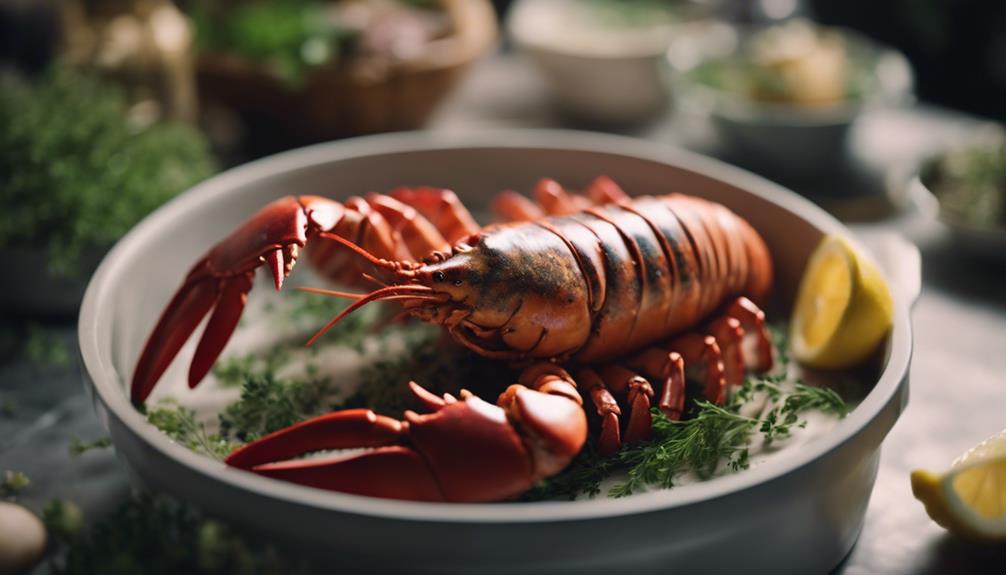
To achieve a velvety sauce for your Butter Poached Lobster Tail, implement the finest technique – Beurre Monté. This method creates a stable emulsion using butter and liquid, enhancing the luxuriousness of the dish.
When preparing the lobster tails, use kitchen shears to carefully remove the meat, ensuring precision and minimal damage. Cook the lobster tails over low heat in the poaching liquid to maintain tenderness.
Thawing frozen lobster tails thoroughly and patting them dry before poaching is essential for even cooking and ideal texture. Keep the poaching liquid at a gentle simmer to prevent overcooking.
Checking the doneness of the lobster tails by observing their opaque appearance helps prevent them from becoming tough and rubbery. By following these cooking techniques, you can elevate your Butter Poached Lobster Tail to a gourmet level, impressing even the most discerning seafood connoisseurs.
Cooking Tips
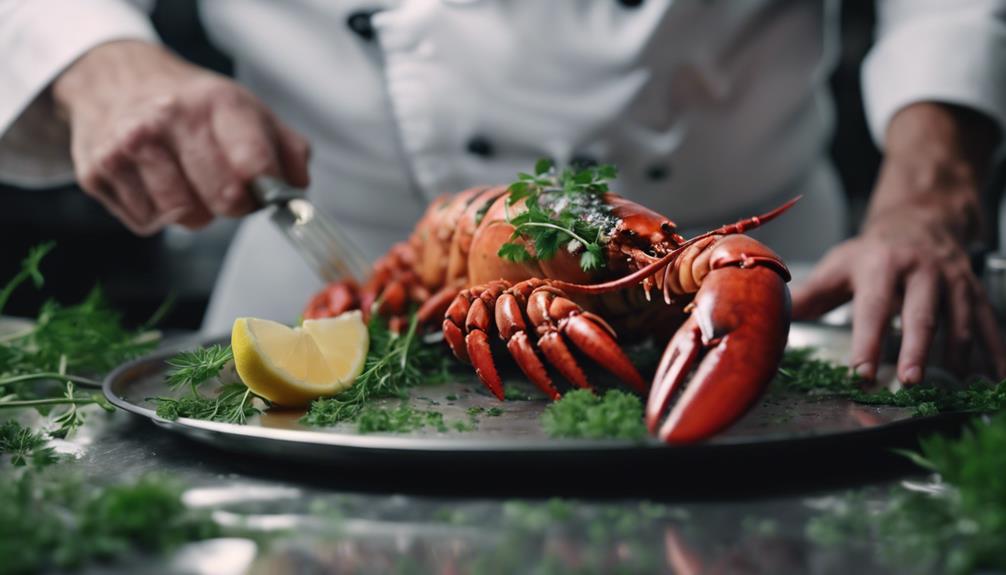
When cooking lobster, using a thermometer guarantees perfect doneness every time.
Thawing frozen lobster tails thoroughly is vital to prevent uneven cooking.
Remember to pat dry the lobster tails before poaching to avoid excess water in the poaching liquid.
Lobster Cooking Techniques
For a perfectly cooked lobster tail, maintain a precise poaching temperature of 180F using a thermometer.
When poaching lobster tails, remember the following tips:
- Thaw frozen lobster tails thoroughly and pat them dry to prevent excess water in the cooking liquid.
- Avoid overcrowding the saucepan to guarantee even cooking of the lobster tails.
- Remove the digestive vein from the lobster tail meat and clean it thoroughly before cooking.
To prepare the Butter Poached Lobster Tail recipe, use unsalted butter, fresh lemon juice, dry white wine, and a pinch of red pepper flakes.
Heat the butter over low heat in a saucepan, add one piece of the cleaned lobster tail at a time, and poach them gently until they reach the desired doneness.
Remember to check the lobster tails a few minutes before the recommended cooking time to prevent overcooking them.
Enjoy the succulent and flavorful lobster tails prepared using these cooking techniques.
Lobster Serving Suggestions
Consider pairing your butter-poached lobster with Chardonnay or Sauvignon Blanc for a delightful wine accompaniment. To complement the succulent lobster, serve it alongside a citrusy quinoa salad or warm baguette slices. Enhance the meal further by adding herbed risotto or lemon-infused asparagus for an explosion of flavors.
When dealing with leftovers, remember to refrigerate them promptly in an airtight container to maintain freshness. When reheating, use a gentle heat setting on a pan. Incorporate a bit of the poaching liquid to keep the lobster moist and prevent it from becoming overcooked. This method will help retain the lobster's tenderness and flavors, ensuring a delicious meal even when reheating.
Serving, Storage, and Reheating
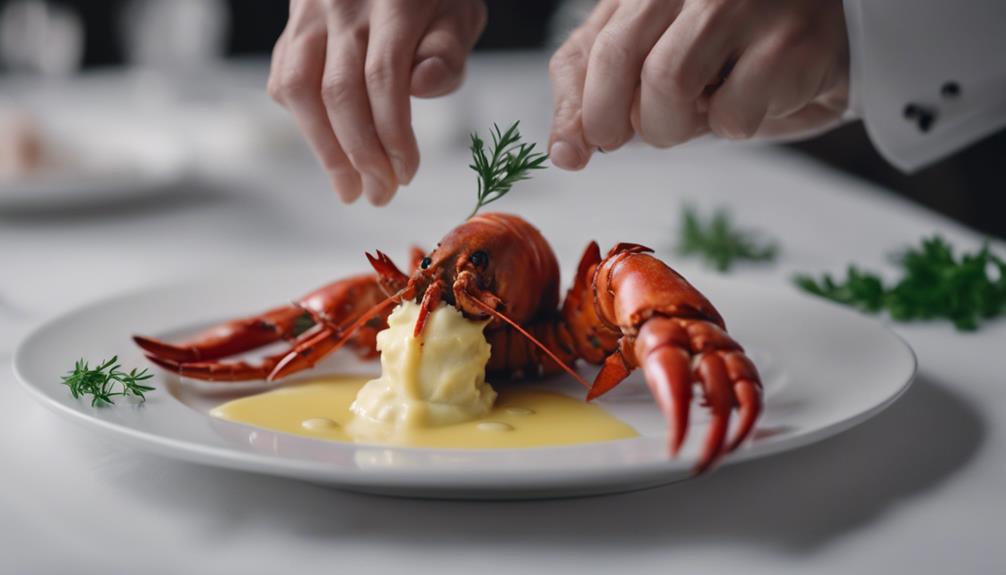
To maintain freshness and flavor, refrigerate any leftover butter-poached lobster promptly in an airtight container.
When it comes to serving, storage, and reheating your delectable lobster, here are some essential tips to guarantee a delightful culinary experience:
- Refrigerate promptly: Store any uneaten lobster in an airtight container in the refrigerator to prevent spoilage and preserve its quality.
- Reheat gently: When reheating, use a pan over low to medium heat to prevent overcooking and maintain the lobster's tenderness.
- Utilize poaching liquid: Incorporate a bit of the poaching liquid when reheating to keep the lobster meat moist and flavorful.
Butter Poached Lobster
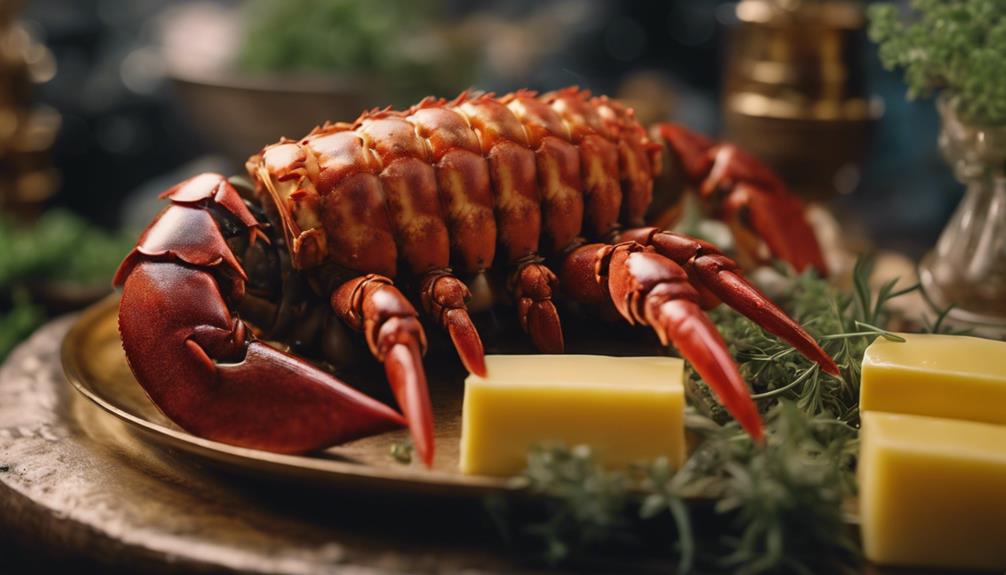
Enhance your culinary skills by mastering-immerse yourself in the exquisite art of butter poached lobster, a decadent dish that elevates the flavors of tender lobster meat with a rich and velvety texture.
Butter poached lobster involves gently cooking juicy lobster in a mixture of butter and white wine, creating a rich and flavorful dish perfect for special occasions. The use of Beurre monté, a French technique, results in a velvety sauce that heightens the delicate texture of the lobster.
The gentle cooking process of butter poached lobster guarantees that the lobster remains tender and juicy, without losing its natural sweetness. The poaching liquid used can also be served alongside the lobster, adding an extra layer of flavor and richness to the dish.
This gourmet delicacy is ideal for those looking to indulge in a luxurious meal at home or impress guests on special occasions.
Elevate Your Cooking

Looking to take your culinary skills to the next level? Elevate your cooking with these expert tips for preparing a gourmet butter-poached lobster dish using uncooked lobster tails and the Beurre monté technique:
- Opt for cold-water lobster tails: Their sweet, delicate flavor and firm texture will enhance your dish, providing a gourmet dining experience.
- Use quality ingredients: Incorporate white wine, garlic, and lemon juice to enhance the natural flavors of the lobster, creating a luxurious and flavorful meal.
- Pair with complementary sides: Serve your butter-poached lobster with herbed risotto or lemon-infused asparagus to further elevate the dish to a gourmet level.
To ensure success, follow key steps like using kitchen shears for precise lobster tail meat removal and maintaining a gentle simmer during cooking. By implementing these techniques and tips, you'll be on your way to impressing your guests with a sophisticated and delicious lobster feast.
Frequently Asked Questions
What Kind of Butter Do Restaurants Use for Lobster?
Restaurants typically use high-quality unsalted butter for butter-poached lobster to control salt levels and enhance lobster flavor. Some may opt for clarified butter due to its higher smoke point. The choice varies based on chefs' preferences and dish style.
What Is the Tastiest Way to Cook Lobster?
When cooking lobster, the tastiest way is to butter poach it. This technique enhances the natural sweetness and delicate flavor of the meat, creating a luxurious, velvety texture. It's a gourmet experience you won't forget.
How to Season Lobster When Boiling?
When boiling lobster, season it with salt and lemon for sweetness. Enhance flavor by adding herbs like thyme or bay leaves. For a kick, throw in garlic, peppercorns, or red pepper flakes. Customize with paprika or cajun seasoning.
What Is Poaching in Butter?
So, what is poaching in butter? Well, it's a gentle cooking method where food luxuriates in warm, melted butter. This technique keeps things moist and intensifies flavors, resulting in tender, silky dishes.
Conclusion
Just like a lobster gracefully glides through the ocean depths, this butter poached lobster recipe will elevate your culinary skills to new heights.
With each succulent bite, you'll feel as though you're diving into a sea of gourmet flavors.
So, don't be afraid to take the plunge and try this luxurious dish – you'll be swimming in deliciousness in no time!
Sunny’s articles radiate enthusiasm, much like her sunny disposition. As our resident “Butter Geek”, she delves deep into the latest butter trends, ensuring our readers are always in the know. Beyond her writing, Sunny’s passion lies in exploring vegan butter alternatives and hosting butter-tasting soirées.
Recipes & Culinary Uses
Creamy Delight: Best Butter Pecan Ice Cream Recipe for Summer!
Yearning for a creamy summer treat that will leave you craving more?
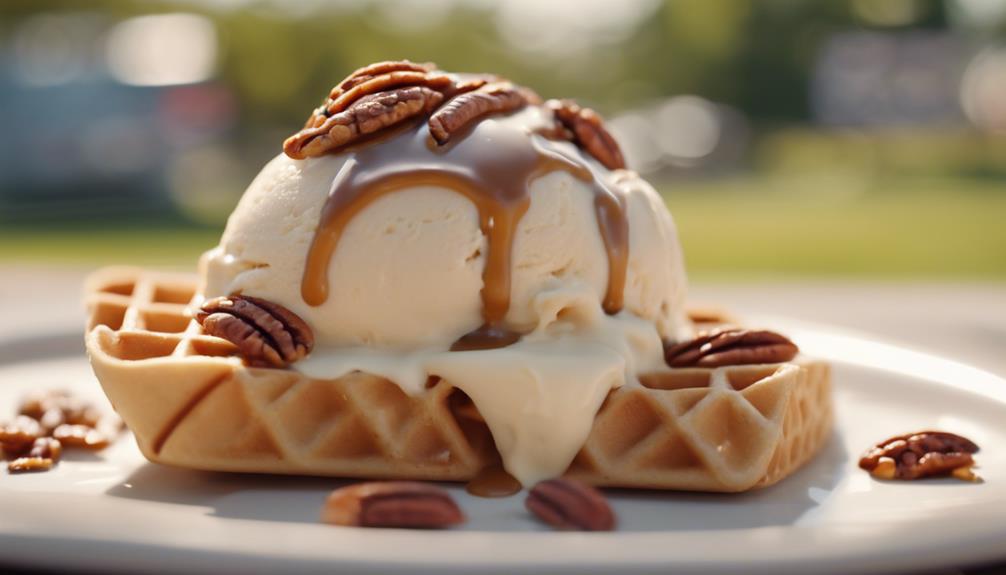
Savor a delicious summer treat with our Butter Pecan Ice Cream recipe. Mix butter, brown sugar, cream, and pecans for a creamy delight. Melt butter, cook pecans, whisk eggs, and blend for a rich flavor. Add pecans, cream, and vanilla, then freeze to perfection. Master this easy-to-follow recipe for a tasty dessert to beat the heat.
Key Takeaways
- Rich and creamy blend of butter, brown sugar, and heavy cream
- Toasted pecans for a nutty crunch and flavor
- Easy-to-follow steps for homemade ice cream perfection
- Customization options with variations like bourbon or chocolate
- Perfect summer treat with a decadent, refreshing taste
Recipe Ingredients for Butter Pecan Ice Cream
To create a delectable batch of butter pecan ice cream, gather the essential ingredients listed in the recipe.
You'll need:
- Butter
- Brown sugar
- Heavy cream
- Pecans
These ingredients combine to bring out the rich and nutty flavors of this classic dessert.
The brown sugar adds a caramel-like sweetness, while the heavy cream contributes to a creamy texture that's essential for a decadent treat.
Pecans, when toasted in butter, provide a delightful crunch and enhance the overall flavor profile of the ice cream.
Cooking Instructions for Homemade Ice Cream
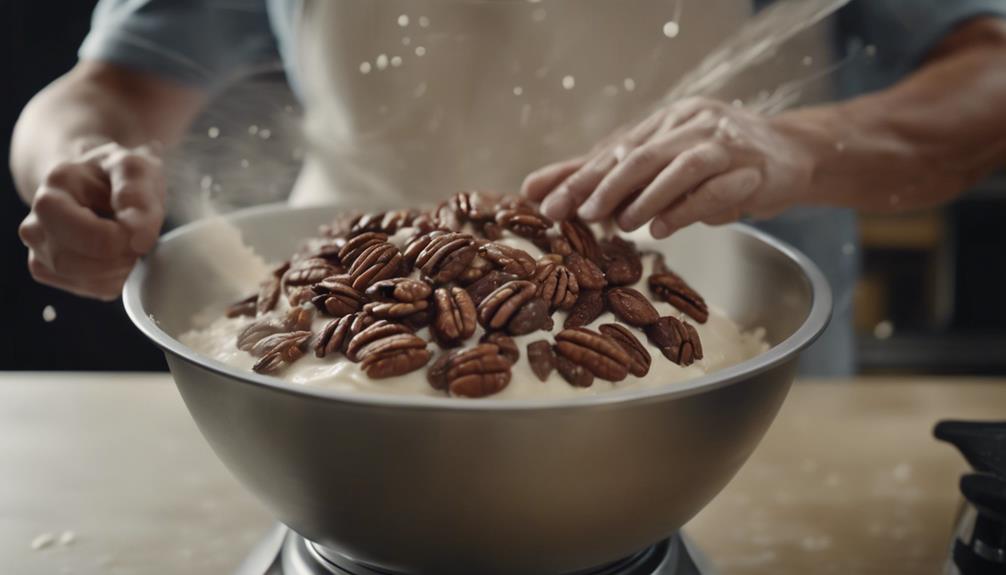
Start by melting butter in a skillet to infuse the pecans with a rich, nutty flavor for your homemade butter pecan ice cream.
Here's a quick guide to help you make this creamy delight:
- Melt butter and cook pecans for flavor.
- Whisk eggs and combine with half-and-half and brown sugar for a creamy base.
- Cook until thickened, then mix with eggs in a bowl.
- Add cream, pecans, and vanilla extract.
- Freeze the mixture in an ice cream maker.
Following these steps will guarantee your homemade butter pecan ice cream turns out rich and delicious.
Remember to carefully adhere to the manufacturer's instructions for your ice cream maker to achieve the perfect consistency.
Enjoy the process of creating this delightful treat that will surely be a hit during the summer months.
Ice Cream Preparation Steps

Mix half and half with brown sugar over medium heat in a large bowl to prepare the ice cream base.
Next, whisk beaten eggs and temper them with the warm milk mixture to create a smooth custard.
Once done, thicken the mixture on low heat, then cool it over an ice bath to achieve ideal texture.
After that, stir in heavy cream, vanilla extract, maple extract, and a pinch of salt for rich flavor.
Remember to refrigerate the mixture for 1 1/2 – 2 hours before churning it into creamy butter pecan ice cream.
This process ensures that the flavors meld together beautifully and the ice cream attains the perfect consistency for scooping and savoring.
Nutritional Information and Tips
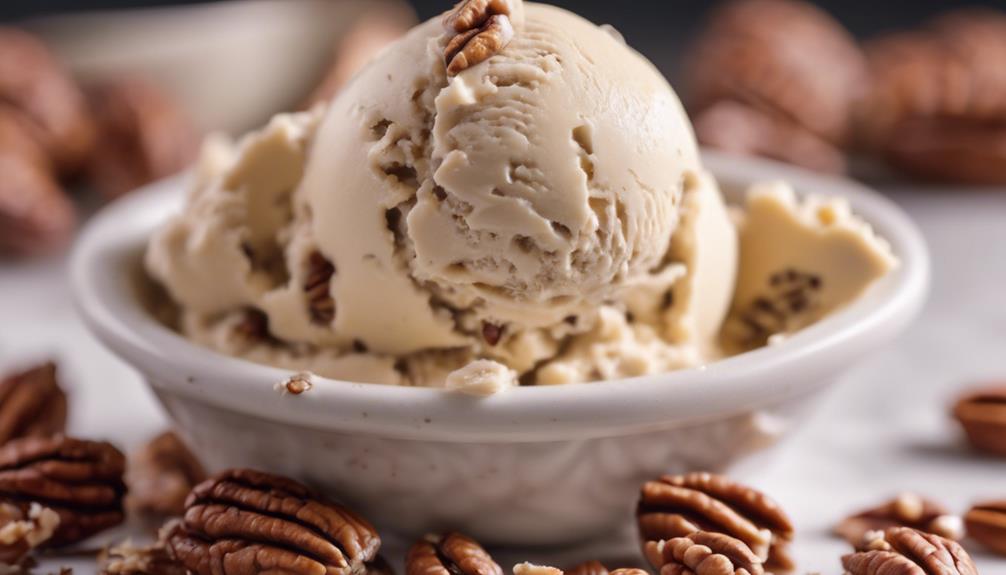
Considering the rich and creamy nature of homemade butter pecan ice cream, it's important to be mindful of its nutritional content and serving size. When indulging in this delectable dessert, remember these essential tips:
- Portion Control: Enjoy in moderation to savor the flavors without overindulging.
- Brown Sugar Sweetness: Opt for a moderate amount of brown sugar to balance sweetness without overwhelming the palate.
- Room Temperature Ingredients: Confirm ingredients like butter and heavy cream are at room temperature for a smoother texture.
- Nutritional Awareness: Be mindful that homemade butter pecan ice cream can vary in nutritional content, so adjust ingredients accordingly.
- Consultation: Seek advice from a nutritionist or healthcare provider for personalized guidance on incorporating this treat into a balanced diet.
Homemade Butter Pecan Ice Cream Variations
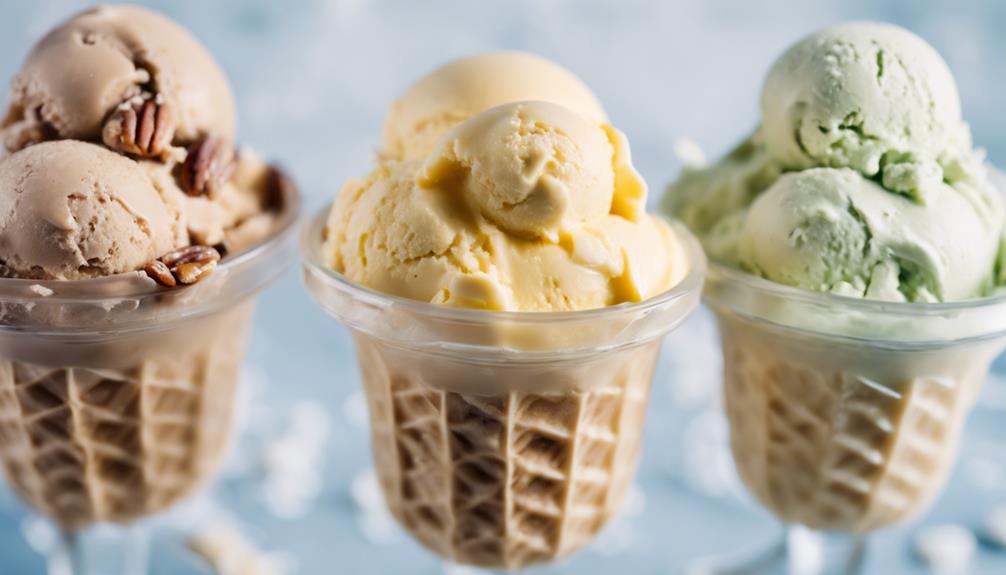
Explore creative twists on traditional butter pecan ice cream by incorporating different nuts, spirits, sauces, chocolates, and dairy-free alternatives.
For a unique flavor, try substituting pecans with walnuts or almonds in the full recipe. Toast the nuts in a separate bowl until browned and fragrant, then chop them finely enough to coat in the ice cream mixture.
To add a boozy kick, mix in a splash of bourbon or rum to the base as you churn the ice cream. For an extra indulgent touch, swirl in caramel sauce or fudge ripple throughout the mixture.
Incorporate chunks of chocolate or chocolate-covered nuts for a delightful contrast in texture, giving each bite a sweet surprise.
If you prefer a lighter, dairy-free option, consider using coconut milk or almond milk as a substitute for traditional dairy products. These alternatives provide a creamy base while catering to plant-based diets.
Experiment with these variations to create a personalized butter pecan ice cream that suits your taste preferences.
Frequently Asked Questions
What Is the Secret to Making Ice Cream Very Creamy?
To make ice cream very creamy, you use a rich base of ingredients like heavy cream, eggs, and sugar. Chilling the base before churning is crucial for a smoother texture. Adding vanilla extract enhances creaminess, and slow churning prevents a dense outcome.
What Flavor Is the Ice Cream in Butter Pecan?
The ice cream in butter pecan is a delightful blend of buttery richness, vanilla sweetness, and maple undertones, perfectly paired with toasted pecans for a nutty crunch. This flavor combination creates a harmonious and indulgent treat.
What's the Difference Between Butter Pecan Ice Cream and Praline Pecan Ice Cream?
In butter pecan ice cream, you'll savor the buttery richness of pecans blended with a creamy base. On the other hand, praline pecan ice cream highlights caramelized sweetness with a swirl of praline sauce for a delightful flavor contrast.
What Age Group Eats Butter Pecan Ice Cream?
You'll find that adults and older individuals, typically in the 30-60 age group, enjoy butter pecan ice cream. It's a favorite among those with a more refined palate, drawn to its rich and nutty flavor.
Conclusion
So there you have it, folks! Whip up this buttery, nutty delight for a taste of summer in every scoop.
Don't cry over spilled milk – grab a cone and enjoy this creamy treat that's sure to satisfy your sweet tooth.
Get churning and indulge in the best butter pecan ice cream you've ever tasted!
Sunny’s articles radiate enthusiasm, much like her sunny disposition. As our resident “Butter Geek”, she delves deep into the latest butter trends, ensuring our readers are always in the know. Beyond her writing, Sunny’s passion lies in exploring vegan butter alternatives and hosting butter-tasting soirées.
Recipes & Culinary Uses
Festive Favorites: Best Peanut Butter Blossoms Recipe for Holidays!
Unleash the ultimate holiday baking magic with the best Peanut Butter Blossoms recipe – an irresistible treat that will elevate your festive celebrations!

Elevate your holiday baking with the ultimate Peanut Butter Blossoms recipe. Cream together peanut butter, butter, sugars, and salt, then add egg and vanilla. Roll dough into balls, coat in brown sugar, bake until golden, then press a Hershey's kiss on top. Adjust baking time as needed. Explore ingredient swaps for a personalized touch. Enjoy with hot cocoa or pair with savory dishes. For more tips, ideas, and customization options, the recipe holds more festive surprises.
Key Takeaways
- Cream together peanut butter, butter, sugars for rich flavor.
- Bake at 375°F for 8-10 minutes for soft, chewy cookies.
- Customize with ingredient swaps like almond butter or maple syrup.
- Pair with savory dishes or hot cocoa for holiday enjoyment.
- Press Hershey kisses onto warm cookies for a classic finish.
Ingredients for Peanut Butter Blossoms
For the classic Peanut Butter Blossoms recipe, gather peanut butter, butter, sugar, an egg, and Hershey's kisses as your essential ingredients.
Peanut butter is the star, offering a rich flavor that blends perfectly with the sweetness of the cookies.
Butter plays a pivotal role by adding moisture and richness to the dough, ensuring a soft and chewy texture.
The sugar not only sweetens the cookies but also contributes to their festive appeal, making them a perfect treat for any occasion.
Finally, the Hershey's kisses on top provide a delightful chocolatey finish that elevates these cookies to a whole new level of deliciousness.
Together, these ingredients create a harmonious blend of flavors and textures that make Peanut Butter Blossoms a beloved classic for holiday baking or any time you crave a sweet and satisfying treat.
Recipe Steps for Peanut Butter Blossoms
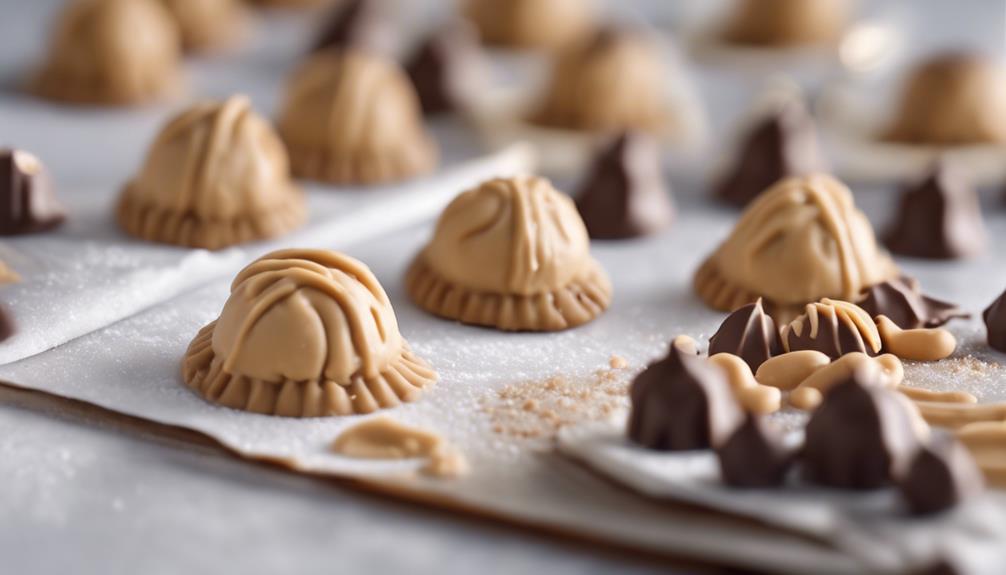
To make Peanut Butter Blossoms, start by creaming together peanut butter, butter, sugars, and salt until light and fluffy.
Next, add in the egg and vanilla extract, making sure to mix well to combine all the ingredients thoroughly.
Then, gradually incorporate the dry ingredients into the wet mixture until a smooth dough forms.
Once the dough is ready, roll it into balls and coat each ball generously in brown sugar.
Place the sugar-coated dough balls on a baking sheet, making sure to leave enough space between them for spreading during baking.
Bake the cookies in a preheated oven until they turn a beautiful golden brown.
As soon as the cookies are out of the oven, press a Hershey's kiss into the center of each cookie gently.
The heat from the freshly baked cookies will melt the chocolate just enough to adhere it to the cookie.
These Peanut Butter Blossoms are a delightful treat perfect for Christmas celebrations!
Pro Tips for Making Peanut Butter Blossoms
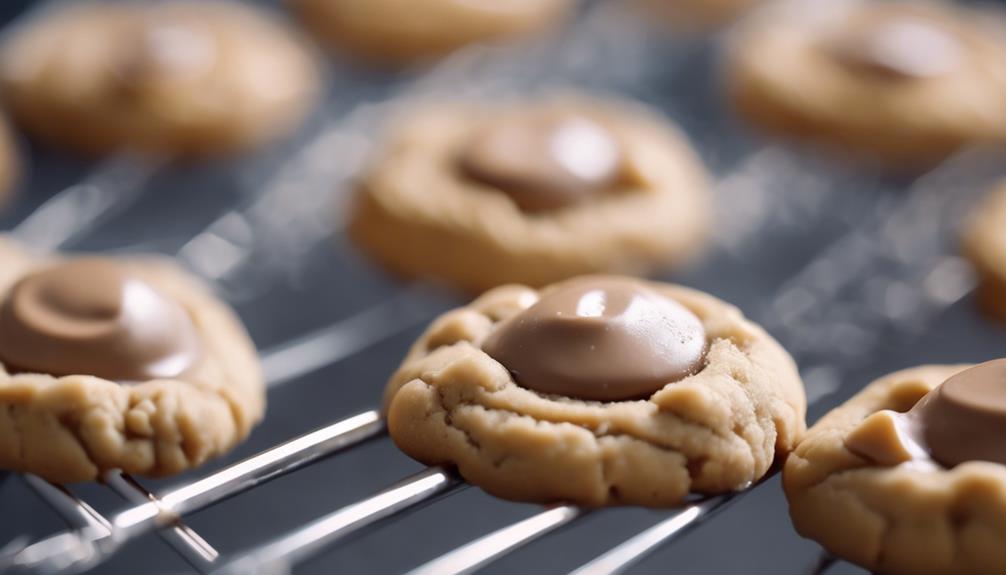
To enhance your peanut butter blossom baking experience, consider adjusting the baking time based on your oven's performance for best results.
Additionally, explore ingredient substitutions to cater to dietary preferences or allergies without compromising the flavor or texture of the cookies.
These pro tips can help you customize your peanut butter blossoms while ensuring delicious outcomes.
Baking Time Recommendations
Achieving the ideal texture for your peanut butter blossoms involves baking them at 375°F for 8-10 minutes. This baking duration guarantees that the cookies have a soft and chewy consistency while allowing the Hershey kisses on top to be softened but not completely melted.
Once out of the oven, remember to press the Hershey kisses onto the cookies immediately to secure them in place for that classic appearance.
For the best outcomes, chill the cookie dough for about 30 minutes before baking. This step helps the cookies maintain their shape and prevents excessive spreading during baking, ensuring your peanut butter blossom cookies are perfectly formed and ready to impress during your holiday baking.
Shortening or extending the baking time can alter the texture of the cookies. A quick bake of 6-8 minutes produces softer and chewier cookies, while longer baking times yield a slightly crispier consistency. Stick to the recommended 8-10 minutes for the best soft and chewy peanut butter blossoms.
Ingredient Substitutions
Consider incorporating different ingredients to elevate the flavor and nutritional profile of your peanut butter blossoms. For a healthier option, swap out shortening with unsalted butter to achieve a unique texture and taste in your cookies.
Try using natural peanut butter instead of creamy to add a wholesome twist to the classic recipe. If you're looking to reduce the glycemic impact, substitute brown sugar with coconut sugar in your baking. For a natural sweetener alternative, replace regular granulated sugar with maple syrup in the cookie dough mixture.
Additionally, for a distinct flavor experience, experiment with almond butter as a substitute for peanut butter in your blossoms. These ingredient substitutions can bring a new dimension to your peanut butter blossoms, making them not only delicious but also tailored to your dietary preferences.
Upgrade your baking game this holiday season with these creative twists on a beloved recipe!
Serving Suggestions for Peanut Butter Blossoms

Enhance the enjoyment of your peanut butter blossoms by pairing them with savory dishes like lasagna tortellini soup for a satisfying meal. These classic cookies also complement family-friendly dinners such as easy ground beef shepherd's pie and creamy broccoli cheddar soup, making for a delightful combination. The holiday season calls for cozy treats, and the sweet nuttiness of peanut butter blossoms pairs perfectly with a warm cup of hot cocoa. Whether you're participating in a cookie exchange or looking for a festive touch to your holiday dessert spread, consider rolling the cookies in red, green, and white sugar sprinkles to add a pop of color and fun.
| Serving Suggestions | Pairing Ideas |
|---|---|
| Lasagna Tortellini Soup | Comforting and hearty meal alongside the cookies |
| Easy Ground Beef Shepherd's Pie | Delicious combination for a family dinner |
| Creamy Broccoli Cheddar Soup | Perfect accompaniment to the nutty cookie flavors |
12 Days of Christmas Cookies Recipes
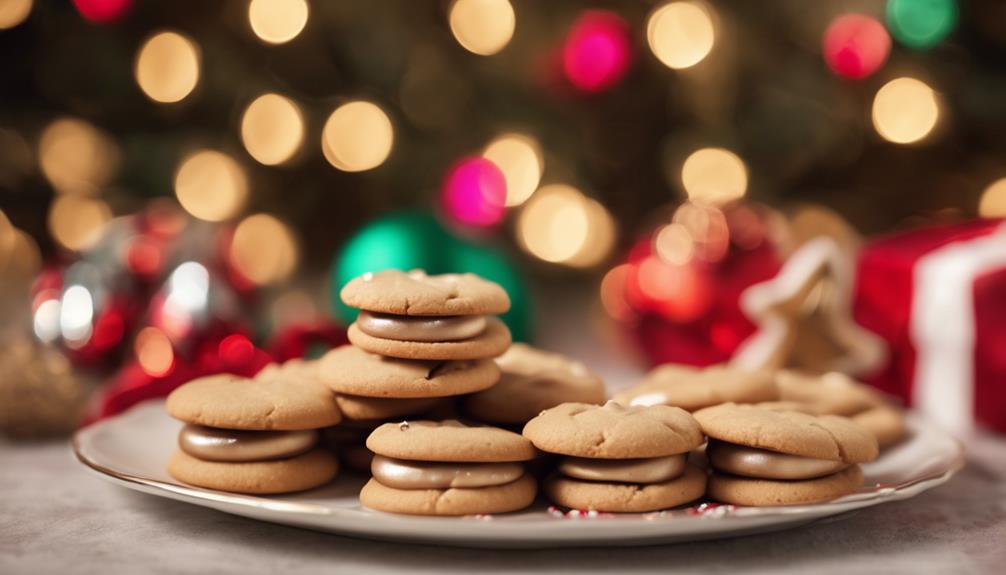
Indulge in a variety of delightful Christmas cookie recipes each day during the holiday season. One standout choice is the classic Peanut Butter Blossoms. These holiday cookies feature a peanut butter base topped with a Hershey's kiss, making them a beloved treat for cookie exchanges and festive gatherings.
The process of making these cookies is simple yet rewarding. Start by rolling the dough balls in sugar before baking to add a sweet crunch to each bite. The combination of rich peanut butter flavor and the chocolatey goodness of the Hershey's kiss creates a perfect balance of sweetness.
When enjoying these Christmas cookies, consider pairing them with a glass of milk for a classic and satisfying treat.
Whether you're baking them for your family, a cookie exchange, or a holiday party, Peanut Butter Blossoms are sure to be a hit. Make each day of the holiday season a little sweeter with these delicious cookies.
User Engagement Features
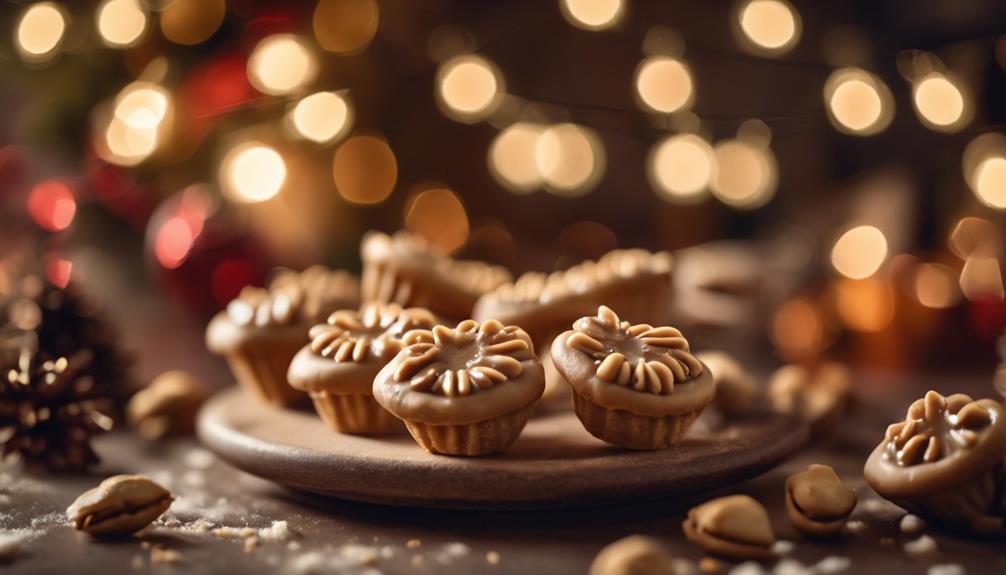
Let's talk about how user interaction features and personalization options enhance your experience with the Peanut Butter Blossoms recipe.
You can engage with others by leaving comments and sharing your results, creating a sense of community around this holiday treat.
Personalization options like name and email entry fields help tailor the experience to your preferences, making it more engaging and enjoyable.
User Interaction Features
Utilizing user engagement features on the website allows for increased participation and feedback from visitors. The comment section enables users to interact with each other and provide valuable feedback on the Peanut Butter Blossoms recipe or share their experiences with Hershey's kisses. By incorporating a reply option, users can engage in conversations, fostering a sense of community around baking these delightful peanut butter cookies.
Moreover, the inclusion of name and email fields not only allows for personalization but also facilitates communication between the website and its visitors. This data storage feature guarantees that users can conveniently access their information for future visits, enhancing their overall user experience.
These user engagement features play an essential role in creating an interactive platform where users can engage, provide feedback, and communicate effectively. Such interaction not only enriches the user experience but also encourages visitors to actively participate in the community surrounding the Peanut Butter Blossoms recipe.
Personalization Options
Enhance your website's user engagement by incorporating personalized options such as commenting, replying, and sharing feedback on the Peanut Butter Blossoms recipe. This level of user interaction not only fosters a sense of community building but also encourages customization and feedback. By allowing users to share their thoughts, results, and experiences with the festive favorites, you create a more engaging and interactive user experience. Additionally, providing users with the option to save their data for future visits and encouraging them to tag @preppykitchen and use #preppykitchen when trying the recipe further enhances their engagement.
| Personalization Options | Description | Benefits |
|---|---|---|
| Commenting | Users can leave comments on the Peanut Butter Blossoms recipe, sharing their thoughts and experiences. | Fosters community building and user engagement. |
| Replying | Users can reply to comments and engage in discussions with other users about the recipe. | Encourages active participation and interaction. |
| Feedback Sharing | Users can share feedback on the recipe, providing valuable insights for improvement. | Enhances user experience and customization. |
Additional Information

You may find it interesting to know more about the history of the Peanut Butter Blossoms recipe and its cultural significance during the holidays.
- The Peanut Butter Blossoms recipe's popularity is backed by IRI MULO data, making it a sought-after choice for holiday baking.
- Copyright for this beloved recipe belongs to The J.M. Smucker Company, a reputable name in the food industry known for quality products.
- These delightful cookies aren't only perfect for serving at holiday parties but also make excellent gifts due to their festive appeal.
Frequently Asked Questions
Why Are My Peanut Butter Blossoms Dry?
If your peanut butter blossoms are dry, it could be due to using too much flour, overbaking, using natural peanut butter that requires stirring, or not enough butter/shortening. Guarantee precise measurements and follow the recipe closely to maintain moisture.
Why Did My Peanut Butter Blossoms Go Flat?
When making peanut butter blossoms, going flat happens due to overmixing, too much flour, insufficient chilling, or low oven temperature. Remember to avoid these pitfalls. Preheat the oven properly and follow the recipe for perfect blossoms!
What Is America's Favorite Christmas Cookie?
America's favorite Christmas cookie is Peanut Butter Blossoms. Loved for their peanut butter-chocolate combo and nostalgic Hershey's Kiss center, these easy-to-make treats are a holiday staple at parties and gatherings. They're a must-have during the festive season.
What Is Baskin Robbins Peanut Butter Blossom?
You asked about Baskin Robbins Peanut Butter Blossom. It's a delectable seasonal ice cream flavor featuring creamy peanut butter ice cream with a ribbon of more peanut butter and chocolate cookie pieces. Indulge in this festive treat!
Conclusion
Indulge in the warm, gooey goodness of these peanut butter blossoms this holiday season. With the perfect blend of creamy peanut butter and rich chocolate, these cookies are sure to bring joy to your festivities.
Picture yourself surrounded by loved ones, sharing laughter and memories as you enjoy these delicious treats. Let the aroma of freshly baked cookies fill your home and create a cozy, festive atmosphere.
Happy baking and happy holidays!
Sunny’s articles radiate enthusiasm, much like her sunny disposition. As our resident “Butter Geek”, she delves deep into the latest butter trends, ensuring our readers are always in the know. Beyond her writing, Sunny’s passion lies in exploring vegan butter alternatives and hosting butter-tasting soirées.
-

 Recipes & Culinary Uses2 months ago
Recipes & Culinary Uses2 months agoHow Many Sticks of Butter Equals a Pound: A Handy Guide
-

 Shopping Guides1 month ago
Shopping Guides1 month agoWhere to Buy Raw Butter
-

 Recipes & Culinary Uses4 weeks ago
Recipes & Culinary Uses4 weeks agoMake Homemade Butter from Milk at Home
-

 Recipes & Culinary Uses4 weeks ago
Recipes & Culinary Uses4 weeks agoMake Creamy Butter From Buttermilk
-

 Butter Tips and Tricks3 months ago
Butter Tips and Tricks3 months agoHow Long Can You Use Butter After the Expiration Date?
-

 Recipes & Culinary Uses2 months ago
Recipes & Culinary Uses2 months agoMake Your Own Homemade Spray Butter
-

 Butter Tips and Tricks3 months ago
Butter Tips and Tricks3 months agoHow Much Butter to Use Instead of 1/3 Cup Oil
-

 Butter Tips and Tricks3 months ago
Butter Tips and Tricks3 months agoHow Many Calories Are in a Stick of Butter: A Comprehensive Guide





















